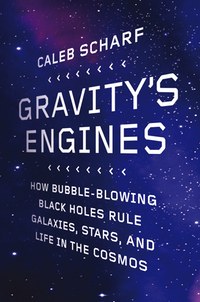Review: Gravity’s Enginesby Jeff Foust
|
| “Black holes are gravity’s engines—the most efficient energy generators in the cosmos,” Scharf writes. “And because of that, they have played a key role in sculpting the universe we see today.” |
Black holes as “energy generators” might strike some people as odd: after all, aren’t black holes objects that swallow up anything that comes too close, never to be seen again? As Scharf explains in the book, though, that energy generation comes from outside the black hole’s event horizon, where material gathers in accretion disks with tremendous amounts of kinetic energy from the black hole’s intense gravitational field. That energy is released in, among other ways, giant bubbles of hot gas, expanding outward into space.
Such bubbles created by supermassive black holes in the cores of galaxies play a major role in regulating their growth. These expanding bubbles push against the flow of gas heading into the cores of galaxies, limiting the amount of gas that can cool and condense into stars. “If they weren’t big and efficient at pushing back,” he writes of these black holes, “we would see far more cooling gas converted into stars, and it would be a very different universe if that had been the case.”
Black holes also play a role in the formation of life, he argues. The Milky Way, like most galaxies, has a supermassive black hole at its core. But, cosmically speaking, it’s rather a small one, weighing in at only about four million solar masses (the one in the core of the nearby Andromeda galaxy, by comparison, is estimated to be about 100 million solar masses.) It is an active black hole, but fortunately spews that energy away from the Earth, sparing us from bursts of X-rays and gamma rays that are not conducive to life. Galaxies like the Milky Way, which “did not spend their past building colossal black holes and fighting the demons unleashed in the process,” may be the ones best suited for life, he concludes.
Scharf writes for the educated layperson in Gravity’s Engines, assuming little background about black holes and building up that knowledge through liberal use of analogies and some historical asides. For someone already familiar with the basics of black holes, that can initially make for some slow reading, but the wait is worth it once he gets into the heart of his argument about black holes being the “engines” that have shaped the universe we know today. Black holes are clearly more than astronomical curiosities that stimulate the imagination. They are objects that have made the universe we live in possible.
